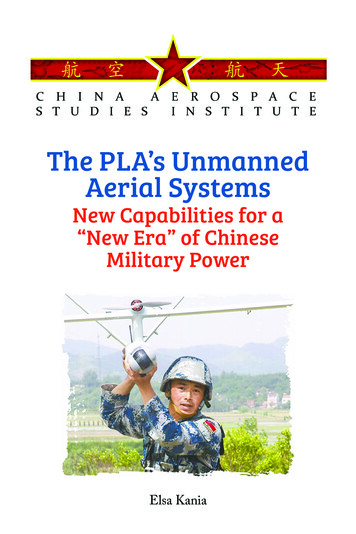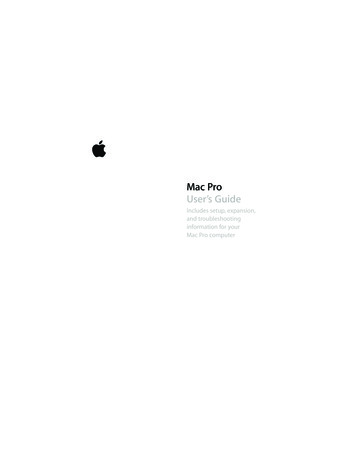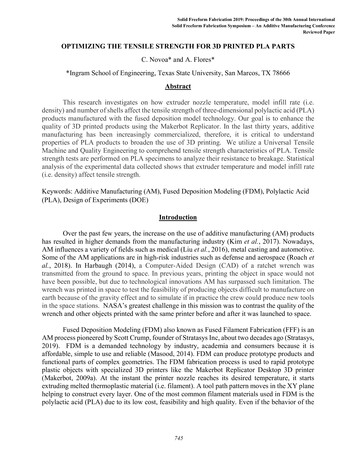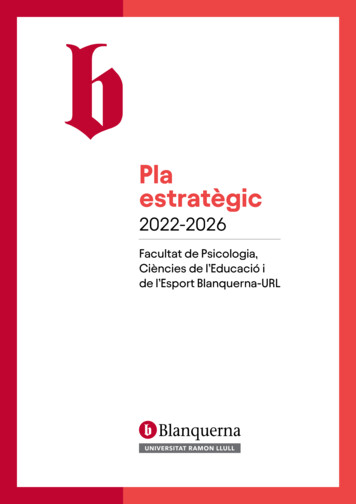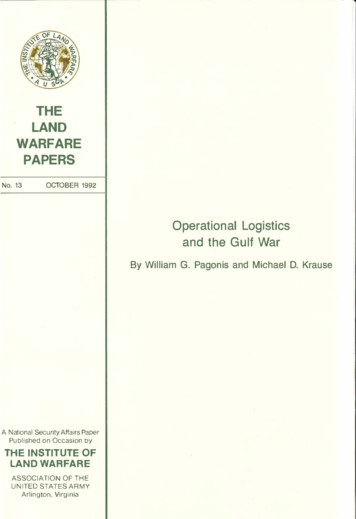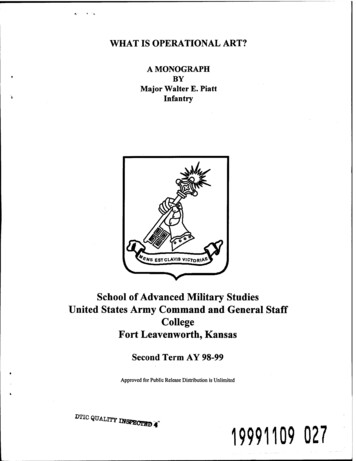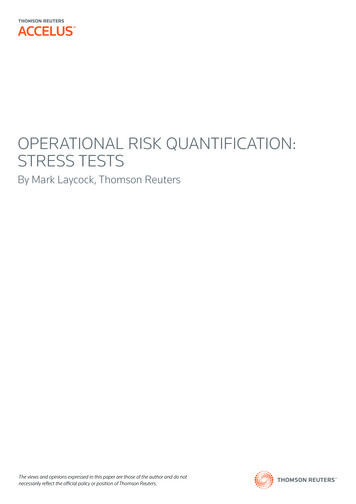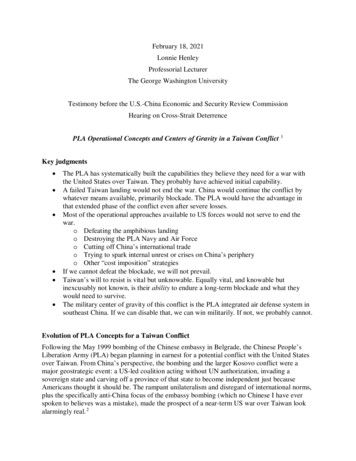
Transcription
February 18, 2021Lonnie HenleyProfessorial LecturerThe George Washington UniversityTestimony before the U.S.-China Economic and Security Review CommissionHearing on Cross-Strait DeterrencePLA Operational Concepts and Centers of Gravity in a Taiwan Conflict 1Key judgments The PLA has systematically built the capabilities they believe they need for a war withthe United States over Taiwan. They probably have achieved initial capability.A failed Taiwan landing would not end the war. China would continue the conflict bywhatever means available, primarily blockade. The PLA would have the advantage inthat extended phase of the conflict even after severe losses.Most of the operational approaches available to US forces would not serve to end thewar.o Defeating the amphibious landingo Destroying the PLA Navy and Air Forceo Cutting off China’s international tradeo Trying to spark internal unrest or crises on China’s peripheryo Other “cost imposition” strategiesIf we cannot defeat the blockade, we will not prevail.Taiwan’s will to resist is vital but unknowable. Equally vital, and knowable butinexcusably not known, is their ability to endure a long-term blockade and what theywould need to survive.The military center of gravity of this conflict is the PLA integrated air defense system insoutheast China. If we can disable that, we can win militarily. If not, we probably cannot.Evolution of PLA Concepts for a Taiwan ConflictFollowing the May 1999 bombing of the Chinese embassy in Belgrade, the Chinese People’sLiberation Army (PLA) began planning in earnest for a potential conflict with the United Statesover Taiwan. From China’s perspective, the bombing and the larger Kosovo conflict were amajor geostrategic event: a US-led coalition acting without UN authorization, invading asovereign state and carving off a province of that state to become independent just becauseAmericans thought it should be. The rampant unilateralism and disregard of international norms,plus the specifically anti-China focus of the embassy bombing (which no Chinese I have everspoken to believes was a mistake), made the prospect of a near-term US war over Taiwan lookalarmingly real. 2
One immediate response to the bombing was a sharp acceleration in the PLA’s hardwaremodernization under the rubric of the 995 Program, an effort that continues today. 3 The PLAalso began exploring what an amphibious invasion of Taiwan would actually require, reflected ina series of studies and field exercises in the early 2000s focused on Taiwan scenarios. 4 To anoutside observer, it appears that the closer they looked at it, the more their initially optimisticassumptions gave way to sober assessments of what such a huge operation – by far the largestamphibious landing any military force has contemplated – would actually require. Getting readyto carry out an invasion was going to take much longer than they initially thought.Luckily, by 2004, geostrategic shifts had reduced the sense of imminent crisis that followed theBelgrade bombing. The United States had become severely distracted after 9/11 and appearedless eager to support Taiwan independence. As observers throughout Asia heard from theirChinese interlocutors, President and Central Military Commission Chairman Hu Jintaoannounced new strategic guidance at a nationwide Taiwan Work Conference in September 2004:“struggle to negotiate, prepare to fight, [but] don’t be afraid to wait” (爭取談,準備打,不怕拖).5 The latter phrase signaled a reversion to China’s earlier view that a Taiwan conflict was notimminent and that the PLA could safely return to long-term rather than immediate preparations.The military aspect of “don’t be afraid to wait” took the form of a phased approach to theoperational capabilities required for various scenarios. Toward the lower end of the conflictspectrum, the PLA needed to go beyond the saber-rattling employed in the 1995-1996 crisis anddevelop the ability to inflict serious pain on Taiwan – hard coercion rather than mereintimidation. Western analysts enumerated several PLA options including air and missile strikes,seizure of offshore islands, commando raids inside Taiwan, and a limited blockade. Analystsjudged that the PLA had achieved the necessary capabilities for these coercive options by 2008,coinciding with the last few months of Taiwan President Chen Shui-bian’s second term. 6The high end of the spectrum would take much longer, however, and there is active debate aboutwhether the PLA is yet capable of a full invasion. Taiwan’s Ministry of Defense concluded in its2020 China Military Power Report (109 年中共軍力報告書) that the PLA cannot yet mount alarge-scale invasion of Taiwan and is limited to blockade or fire strikes. 7 This Commissionreached the same conclusion in its 2020 Report to Congress. 8 The US Department of Defensedeclined to make a call in its own 2020 report, noting that “China continues to build capabilitiesthat would contribute to a full-scale invasion” but that “[a]n attempt to invade Taiwan wouldlikely strain China’s armed forces and invite international intervention.” 9I am on the other side of this debate, judging that the PLA probably has achieved the initialtargets it set for itself for a capability to invade Taiwan. I base this judgment on severalsupporting arguments: They clearly had such a target and still do. Many aspects of PLA hardwaremodernization, doctrinal development, force structure, and operational training makeclear that operations to invade and occupy Taiwan remain central to PLA forcedevelopment and “Army building.” Over the past two decades the operational concepthas evolved to include comprehensive “three-dimensional” air, sea, and amphibiousoperations with urban warfare, special operations, cyber, space and counterspace, “threewarfares” (psychological, diplomatic, and legal), and nuclear deterrence components.2020 was probably the initial date set for that target. Absent some external constraint,such as Chen Shui-bian’s term in office, PLA force development programs tend to align
with five-year planning cycles such as the 2016-2020 13th Five Year Plan. From theviewpoint of 2004, when the initial decisions were made, 2010 or 2015 would not be longenough to build the required capabilities, leaving 2020 or 2025. There has been no publicstatement from Beijing about the target date for invasion capabilities, but there have beenample statements about the PLA’s overall force modernization milestones, all listing2020 prominently but none mentioning 2025. 10The PLA probably built what it was scheduled to build during the 11th, 12th, and 13th FiveYear Plans. Aside from the aeroengine program, which remains an ongoing disaster forChina, I see no indication of a major failure in any of the PLA’s force modernizationefforts.I therefore conclude that the PLA had a force development plan for being able to invade Taiwan;that they executed that plan on schedule; and that they have now achieved whatever it was theyset out to achieve fifteen years ago.Those who disagree with me make several arguments: 11 Maybe the PLA never had such a goal, or gave up on it because it was too hard. I findthe first to be unsupportable; the PLA incessantly talks about and trains for large-scaleisland landing operations. The latter seems inconsistent with the PLA’s continued publicemphasis, including the large amphibious landing exercises that attracted attention thispast fall. 12Maybe the apparent effort to build invasion capabilities is just a stratagem, intended tointimidate but not expected to achieve actual invasion capabilities. Possible, but it seemslike a very expensive bluff, and I see nothing beyond speculation to support thatconjecture.Maybe 2020 was never the goal, or maybe the goal has shifted to a later date. I havemade my arguments on the former. The latter is possible, but again there is no hardevidence to support it.The disagreement centers on the PLA’s perceived lack of enough lift capacity to deliver therequired force across the Strait and sustain it in combat. Clearly, they have less amphibious liftthan American planners would deem necessary. I see only a few possible interpretations: The PLA tried but failed to add enough lift. This is implausible; amphibious ships arewell within China’s shipbuilding capacity, and a failure of that magnitude would havepolitical consequences impossible to conceal.The PLA never really intended to build enough lift. This is a reiteration of the stratagemargument above.They intend to build it, but the target date is later than 2020. This is a reiteration of thetiming argument.The PLA believes it has built enough for at least an initial landing capability. Thisrequires a different concept for how to deliver forces, relying less on military ships andmore on civilian vessels.I find the latter interpretation the most viable: they set 2020 as a target and built what theybelieved essential, which happens not to match what we might deem essential. The alternativeapproach centers on large-scale employment of civilian ships and aircraft to augment military
lift. A fuller examination of that concept of operations would take this paper far afield, so I leavethat for a separate discussion.That is not to say that I believe a cross-Strait invasion would succeed. It would be a very difficultoperation with a high risk of failure. I am merely saying that the PLA probably believes it iscapable of executing that operation now if called upon, and that its capabilities will continue togrow in coming years.A Failed Landing would not End the WarIf ordered to compel reunification by military force, the PLA would bring every tool to bear.Among its most effective lines of operations would be a long-term air, maritime, and informationblockade of Taiwan. Such a blockade could be the main effort, eschewing an attempted landingaltogether, or it could be part of a larger invasion campaign. Most importantly, even if thelanding failed, the PLA could continue the blockade indefinitely and neither US nor Taiwanforces would have much ability to overcome it.The Communist Party (CCP) leadership could not afford to accept defeat. The passions arousedby the war itself and by the propaganda effort in support of the war would not allow the Party tostop short of a political outcome they could credibly sell as a victory. If such a formula wereavailable in the immediate wake of a failed landing, they might be tempted to take it. If not, theywould have no choice but to continue the conflict by whatever means remained.Even at this point in the conflict, after weeks or months of intense fighting, the loss of much ofits landing force, expenditure of its ballistic missile inventory, and very severe attrition of itsnavy and air force, the PLA could still have the upper hand in enforcing the blockade. Thedistinctive geography of the Taiwan theater would finally start working in the PLA’s favor andits remaining short-range strike assets would still be useful.The geography would strongly favor China. Whatever flow of imports were required to keepTaiwan alive – more on that later – would have to enter through the same west coast ports thatwould have played a prominent role in the invasion attempt. The east coast ports would be of aslittle use for relief supplies as they were for the PLA landing effort, cut off as they are byextreme terrain and very austere transportation links from the rest of Taiwan. If the west coastports remained functional at all – a big “if” at this point – then relief convoys would have tonegotiate the narrow seaward approaches while less than 100 miles from the Chinese coast,exposed to withering fire from shore-based rockets, cruise missiles, patrol craft, mines, andwhatever air assets and submarines remained. Cargo aircraft would fare no better if the PLA’slong-range air defense systems remained functional – again, more on that later.In my assessment, China could continue the blockade operation indefinitely even with theseverely diminished force that remained after a failed landing and months of air and navalattrition. US forces could probably push through a trickle of relief supplies, but not much more.The United States has Few OptionsMost of the operational approaches available to US forces would not serve to end the war.Defeating the landing operation is feasible given a large enough US effort, but to repeat myearlier point, that would merely move the war into the next very extended phase. It would not
end the military conflict, nor would it necessarily go very far toward creating the conditions for apolitical settlement.In my observation, the thinking about potential US courses of action centers on the followingapproaches: 13 Defeating the invasion. Attacking the invasion force as it crosses the strait, to include thesupporting logistics effort; assisting Taiwan’s effort to repulse the force as it lands.Destroying the PLA Navy and Air Force.Economic punishment. Cutting off China’s international trade and access to theinternational financial system, with particular emphasis on energy supplies.Political punishment. Threatening the CCP’s hold on political power by supportingseparatist groups or fomenting unrest inside China.The first two have the virtue of centering on things we’re already good at – sinking ships andshooting down airplanes, at least when the airplanes are not inside a good air defense umbrella.They also have the advantage of being big enough to let everyone play, even the Army andMarine Corps with their new land-based anti-ship artillery. 14 They provide a central role forsome of the platforms most prized by the services – fighters, bombers, aircraft carriers,submarines, artillery. (Though not air defense artillery. Defending air bases from missile attack isan Army mission, but it does not seem to be one the Army relishes.) But such preparations do notleave us ready to deal with a blockade.All of these approaches, military, political, and economic, share an unexamined faith in “costimposition.” The assumption is that if we can make the conflict costly enough, the Chinese willback down. Michèle Flournoy’s recent Foreign Affairs article encapsulates this outlook:“For example, if the US military had the capability to credibly threaten to sink allof China's military vessels, submarines, and merchant ships in the South ChinaSea within 72 hours, Chinese leaders might think twice before, say, launching ablockade or invasion of Taiwan; they would have to wonder whether it was worthputting their entire fleet at risk.” 15The problem is that Chinese leaders certainly would think far more than twice before going towar against the United States. The military cost is only one of myriad reasons not to do it, andnot the most important reason by far. If they decide they must do so anyway, they will havemade that decision in full acceptance that the war will be economically devastating to China fordecades to come and that its failure would severely endanger the Communist Party’s hold onpower. At that point, the “cost imposition” dial is at 11; it won’t go any higher.This brings us back to my central point: if we can’t defeat the blockade, we can’t prevail.Taiwan’s Will and Ability to ResistThere has been a good deal of discussion about whether the Taiwan public and elites have thepolitical will to endure the horrific punishment China would rain down on them. Would Taiwancrumble at the first blow, like many mainland Chinese observers seem to believe? Or would theyrise to the Churchillian moment, fighting on the beaches, on the landing grounds, in the fieldsand streets and hills, vowing to never surrender? No one knows. Many have opinions, but this isessentially unknowable.
Despite this uncertainty, both US and Taiwan operational concepts assume a vigorous resistanceagainst the PLA landing. 16 Indeed, assuming and planning for such resistance is an importantpart of making it happen, should push ever come to shove. But all discussion among both US andTaiwan observers focuses on defeating the landing. There is no discussion whatsoever of whathappens next, if the PLA doesn’t just go away to lick its wounds as we think it should.Unlike Taiwan’s will to resist, its ability to resist a long-term blockade is something we shouldknow much more about than we do. I am aware of no study in the United States or Taiwanexamining Taiwan’s wartime consumption rate of critical materials, its peacetime stockpiles, orwhich stockpiles would likely be lost to PLA fires. There is no assessment of what must getthrough a blockade to keep Taiwan alive, what types of materiel in what quantities, or whatTaiwan’s domestic production of food, water, supplies, and equipment might be under wartimeconditions. And to the best of my knowledge, no one has considered in detail how to get enoughmateriel through a PLA air and maritime blockade, day after day, week after week, whileworking to break down the blockade itself.Potential Approaches to Defeat the BlockadeSuppression of Air Defenses. The center of gravity for this entire conflict, in my judgment, isthe PLA air defense network. Over many years of participating in Taiwan Strait war games andtabletop exercises, I observe that Taiwan’s air defenses are almost always disabled within thefirst few days of the conflict, but China’s integrated air defense system (IADS) along the TaiwanStrait remains effective for as far into the conflict as the exercise examines. This in turn limitsthe United States to long-range stand-off weapons or precision-strike incursions by stealthplatforms. I assume I am not the only person to have observed this and that US forces areworking on the issue.Success in this area would have the greatest impact on the overall conflict, more even thanfinding a way to defend US air bases from Chinese missile strikes. Poorly defended bases willstill generate some combat sorties, particularly as the conflict drags on and the Chinese expendtheir inventory of theater-range missiles. But a functioning air defense network greatly reducesthe impact those sorties can have. Conversely, defeating the Chinese IADS would open the doorto the kind of air campaign that has proven decisive against less capable opponents.More specifically, enabling US air operations over the Strait would be our best hope for gettingcargo into Taiwan’s western ports. The PLA’s short-range anti-ship assets can be extremelyeffective under a tight air defense umbrella, but much less so in the glare of US air power. ThePLA air blockade, meanwhile, simply ceases to exist without the IADS.Mine Clearing. Even if US air cover opens the way for cargo ships, it is highly likely that Chinaor Taiwan or both will have mined the harbors extensively. The blockade is not defeated untilenough shipping gets through, and that cannot happen until enough mines are cleared. Thiswould be a large operation and time would be of the essence.The US Navy’s newly-developed mine warfare strategy reportedly centers on minecountermeasure (MCM) modules aboard Littoral Combat Ships rather than dedicated MCMships. 17 It is not clear from publicly available information what overall mine clearing capacitythe Navy envisions, how that compares to the scale of a Taiwan blockade mine-clearing effort, oreven whether any study has determined how large that effort needs to be.
ConclusionUS analysts and force developers have devoted a great deal of thought to how we would defeat aChinese invasion of Taiwan. We have been at it long enough for operational concepts to matureinto weapons and force development programs, from the Long Range Anti-Ship Missile toreviving the Tomahawk’s anti-ship role to the US Army Multi-Domain Operations Concept. 18But if we succeed, then what? We haven’t devoted nearly enough attention to the next, muchlonger phase of the conflict.Penetrating a Chinese blockade of Taiwan would be a slow, grinding battle stretching over manymonths. It would not be the kind of rapid, decisive combat that US forces prefer, but it woulddecide the outcome of the war. It is vital that we begin giving this phase of a potential Taiwanconflict the same serious attention we have given the landing phase.
1The author is retired from the US Department of Defense. The views expressed here are the author’s alone and donot necessarily reflect those of the Department of Defense or any other part of the United States Government.Cleared for open publication by Department of Defense Office of Prepublication and Security Review, February 4,2021.2Baidu online encyclopedia, “Kosovo Incident (科索沃事件) , https://baike.baidu.com/item/科索沃事件, accessedJanuary 2021; Zhu Mingquan 朱明权, “The Kosovo War’s Threat to International Stability” (科索沃战争对世界稳定的危害), Exploration and Debate《探索与争鸣》September 2009, pp. 39-41,https://cas.fudan.edu.cn/picture/1587-pdf; Wang Fuqun 王福春, “China's Foreign Relations Strategy after theKosovo War and Cold War” (科索沃战争与冷战后的中国外交战略) February 4, ml.3“The PLA’s Secretive ‘995 Program’ Generated a Blowout in the Development of Weapons and Equipment” (解放军神秘“995 工程” 使武器装备呈井喷式发展), Global Times 环球时报, March 13, 2956.shtml.4My favorite of these was a set of articles by the commander of the 38th Mechanized Group Army, then China’sonly corps-sized mechanized unit, and his subordinate division commanders summarizing field exercises focused onbreak-out operations in the second echelon of a large island landing. “A Selection of Articles on Research intoIssues of Joint Tactical Formations at the 65521 Unit” (66521 �), MilitaryArt Journal 军事学术 (Beijing), December 2003, pp. 45-51.5“’Struggle to negotiate, prepare to fight, but don’t be afraid to wait’ over Taiwan” (對台「爭取談,準備打,不怕拖」). United Daily News 聯合報 (Taipei), September 27, 2004, http://city.udn.com/50248/1052471;“Hu Jintao's ‘Not Afraid of Procrastination’ vs. Xie Changting's ‘Shooting the Moon’” (胡锦涛“不怕拖”vs 谢长廷“射月论”), Chinese Herald 中文导报 (Tokyo), 2005 Issue 2 (February 2005), p. ticle.php/9861/c06Office of the Secretary of Defense, Annual Report to Congress: Military Power of the People’s Republic of China,2008, pp. 43-44.7Youth Daily News 青年日報 (Taipei), “2020 Communist China Military Power Report: Security ChallengesAcross the Taiwan Strait are More Severe” (“109 年中共軍力報告: 臺海安全挑戰更嚴峻”), August 31, apterID 1256680. Also Taipei Times in English, “China notready for full assault: report,” September 1, es/2020/09/01/2003742623.8US Congress, United States-China Economic and Security Review Commission, 2020 Report to Congress of theU.S.-China Economic and Security Review Commission, December 2020, p. 395.9Office of the Secretary of Defense, Annual Report to Congress: Military and Security Developments Involving thePeople’s Republic of China 2020, p. 114.10“Leap Ahead, Towards a World-Class Army – How to View the Strategic Plan for Comprehensively Advancingthe Modernization of National Defense and the Armed Forces” (跨越,向着世界一流军队 �的战略安排), Liberation Army Daily 解放军报, November 14, ontent 220624.htm.11This discussion is based on personal conversations with colleagues over the past ten years.12“Fire and Fury: China stages terrifying Taiwan invasion drill with rockets, drones and thousands of airborne andamphibious troops.” The Guardian, October 12, 2020, aryexercise-taiwan-invasion-island-troops/.13Based on the author’s conversations with colleagues over the past decade.14David Axe, “Could the Marine Corps Kill Ships with Rockets? Maybe—If the F-35 Helps” The National InterestDecember 31, 2019, lps-109731; US Indo-Pacific Command, “RIMPAC Units Participate in SinkingExercise,” July 13, 2018, g-exercise/.
15Michèle A. Flournoy, “How to Prevent a War in Asia: The Erosion of American Deterrence Raises the Risk ofChinese Miscalculation,” Foreign Affairs June 18, 2020, es/2020-06-18/how-prevent-war-asia.16Lee Hsi-min and Eric Lee, “Taiwan’s Overall Defense Concept, Explained: The concept’s developer explains theasymmetric approach to Taiwan’s defense,” The Diplomat, November 3, ll-defense-concept-explained/.17Office of the Chief of Naval Operations, Report to Congress on the Annual Long-Range Plan for Construction ofNaval Vessels for Fiscal Year 2020, March 2019, 1/1/0/SHIPBUILDING%20PLAN%20DEC%2020 NAVY OSD OMB FINAL.PDF/SHIPBUILDING%20PLAN%20DEC%2020 NAVY OSD OMB FINAL.PDF; Kris Osborn, “Mine Warfare Is A Big Part Of The Navy's NewMaritime Strategy,” The National Interest, March 4, 2020, nge-anti-ship-missile.html; John Kellor, “Raytheon eyesguidance sensor and processor to enable Tomahawk missile to hit moving enemy vessels at sea,” Military &Aerospace Electronics, August 23, 2019, 14038802/tomahawkmissile-antiship-upgrade; Sean Kimmons, “Army to build three Multi-Domain Task Forces using lessons frompilot.” Army News Service, October 15, 2019,https://www.army.mil/article/228393/army to build three multi domain task forces using lessons from pilot;Wyatt Olson, “Army test-fires naval strike missile off Hawaii,” Stars and Stripes, July 13, naval-strike-missile-off-hawaii-1.537468; Christopher Woody,“Watch The US And Its Allies Blow The Hell Out Of A Warship In A Clear Message To China,” Task & Purpose,July 18, 2018, -sinks-warship-china/.
3 The PLA also began exploring what an amphibious invasion of Taiwan would actually require, reflected in a series of studies and field exercises in the early 2000s focused on Taiwan scenarios.4 To an outside observer, it appears that the closer they looked at it, the more their initially optimistic
